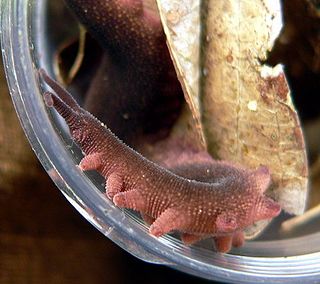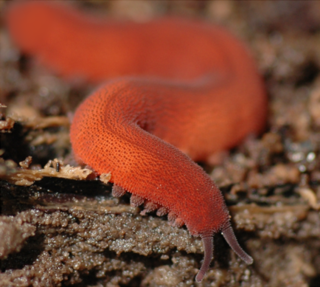
Peripatus is a genus of velvet worms in the Peripatidae family. The name "peripatus" is also used to refer to the Onychophora as a whole, although this group comprises many other genera besides Peripatus. The genus Peripatus is found in Central America, the Caribbean and northern South America. Velvet worms in this genus can have as few as 24 or 25 pairs of legs or as many as 36 leg pairs. This genus is viviparous, with mothers supplying nourishment to their embryos through a placenta.
Macroperipatus is a genus of Neotropical velvet worms in the Peripatidae family. Velvet worms in this genus can have as few as 24 pairs of legs or as many as 42 leg pairs. This genus is viviparous, with mothers supplying nourishment to their embryos through a placenta.

Peripatopsis is a genus of South African velvet worms in the Peripatopsidae family. The number of legs in this genus ranges from as few as 16 pairs to as many as 25 pairs and varies within species when the number is greater than 18 pairs. Velvet worms in this genus feature a last pair of legs that is rudimentary or reduced in size, mainly in males. This genus exhibits matrotrophic viviparity, that is, mothers in this genus retain eggs in their uteri and supply nourishment to their embryos, but without any placenta.
Plicatoperipatus is a monospecific genus of velvet worm containing the single species Plicatoperipatus jamaicensis. It is endemic to Jamaica. Females of this species can have as many as 43 pairs of legs, the maximum number found in the phylum Onychophora. In a large sample collected in 1988, however, females ranged from 35 to 39 leg pairs, with 37 as the mean and the most common number, and males ranged from 31 to 37 leg pairs, with 35 as the mean and the most common number. This species ranges from 25 mm to 65 mm in length. In the 1988 sample, the mean length for males was 33 mm, and the mean length for mature females was 51 mm. This species is viviparous, with mothers supplying nourishment to their embryos through a placenta.
Speleoperipatus is a monospecific genus of velvet worm in the Peripatidae family, containing the single species Speleoperipatus spelaeus. This species is a pale greenish yellow, almost white, with 22 or 23 pairs of legs and no eyes. Specimens range from 27 mm to 34 mm in length. The minimum number of leg pairs found in this species (22) is also the minimum number found in the neotropical Peripatidae. This velvet worm is viviparous, with mothers supplying nourishment to their embryos through a placenta.

Peripatidae is a family of velvet worms. The oldest putative representatives of the family herald from Burmese amber dated to the mid-Cretaceous, around 100 Ma, with representatives from Dominican and Baltic amber attesting to a broader distribution in the Palaeogene / Neogene; molecular variability suggests that the family's crown group may have arisen in the early Mesozoic.

Eoperipatus is a Southeast Asian genus of velvet worm in the family Peripatidae. The number of legs in this genus varies within species as well as among species and ranges from 22 pairs to 25 pairs. This genus exhibits lecithotrophic ovoviviparity; that is, mothers in this genus retain yolky eggs in their uteri.

Epiperipatus is the most diverse genus of neotropical velvet worms in the family Peripatidae. Species in this genus are found in Central and South America. Velvet worms in this genus can have as few as 23 pairs of legs or as many as 39 leg pairs. This genus is viviparous, with mothers supplying nourishment to their embryos through a placenta.

Oroperipatus is a genus of Neotropical velvet worms in the family Peripatidae. Species in this genus are found in South America west of the Andes and in Mexico. Velvet worms in this genus can have as few as 22 pairs of legs or as many as 40 leg pairs. This genus is viviparous, with mothers supplying nourishment to their embryos through a placenta.
Cerradopatus is a monospecific genus of velvet worm containing the single species Cerradopatus sucuriuensis. Males of this species have 28 or 29 pairs of legs; females have 30 to 32. This species is native to the Brazilian savannah. This species is viviparous, with mothers supplying nourishment to their embryos through a placenta.
Metaperipatus is a genus of velvet worms in the family Peripatopsidae that includes the species Metaperipatus inae. Males of this species have 20 pairs of legs; females have 22 pairs. This species is a dark grayish blue in color, with large orange/red spots. When walking, females of this species can be as long as 85 mm, and males can be as long as 60 mm. The type locality is in central Chile.
Paropisthopatus is a monospecific genus of velvet worm containing the single species Paropisthopatus umbrinus. Females of this species range from 20 mm to 70 mm in length. The type locality is in central Chile. Velvet worms in this genus have 16 pairs of legs. This genus exhibits matrotrophic viviparity, that is, mothers in this genus retain eggs in their uteri and supply nourishment to their embryos, but without any placenta.
Opisthopatus cinctipes is a species of velvet worm in the Peripatopsidae family. This species has 16 pairs of legs, all with claws and all used for walking. Females range from 7 mm to 50 mm in length, whereas males range from 6 mm to 36 mm. Like other velvet worms in this genus, this species exhibits matrotrophic viviparity, that is, mothers in this genus retain eggs in their uteri and supply nourishment to their embryos, but without any placenta. The type locality is in South Africa.
Heteroperipatus clarki is a species of velvet worm in the Peripatidae family. Females of this species have 26 to 29 pairs of legs. The original description of this species is based on a female specimen measuring 100 mm in length. The type locality is in Panama.
Heteroperipatus engelhardi is a species of velvet worm in the Peripatidae family. Males of this species have 27 or 28 pairs of legs; females have 31 or 32 leg pairs. Females range from 24.5 mm to 52 mm in length; males range from 12 mm to 25 mm in length. The type locality is in El Salvador.
Oroperipatus lankesteri is a species of velvet worm in the Peripatidae family. This species is brownish grey and is notable for its large size, which ranges from 32 mm up to 82 mm in length. Females of this species have 37 or 38 pairs of legs; males have 33 to 35 pairs. Like other neotropical peripatid velvet worms, this species is viviparous, with mothers supplying nourishment to their embryos through a placenta. The type locality is in Ecuador.
Peripatus dominicae is a species of velvet worm in the Peripatidae family. Males of this species have 25 pairs of legs; females can have 28 to 31 pairs of legs, but usually have 29. Females in this species range in size from 29 mm to 56 mm in length, while males range from 17 mm to 25 mm in length. The original description of preserved specimens report that this species is usually reddish brown with a diffuse darker streak down the middle of the back, with a much paler "light grey or greyish yellow" ventral surface. Like other neotropical peripatid velvet worms, this species is viviparous, with mothers supplying nourishment to their embryos through a placenta. The type locality is in Dominica.
Mongeperipatus solorzanoi, or Solórzano's velvet worm, is a species of velvet worm in the Peripatidae family. Like other neotropical peripatid velvet worms, this species is viviparous, with mothers supplying nourishment to their embryos through a placenta.
Peripatopsis sedgwicki is a species of velvet worm in the Peripatopsidae family. This species can have either 20 or 21 pairs of legs, but descriptions have usually reported 20 pairs of clawed legs. Females of this species range in size from 12 mm to 68 mm in length, whereas males range from 10 mm to 46 mm in length. The color of this species varies from blue-tan green to bright orange and brown violet. Like other velvet worms in this genus, this species exhibits matrotrophic viviparity, that is, mothers in this genus retain eggs in their uteri and supply nourishment to their embryos, but without any placenta. The type locality is in South Africa.

Peripatopsis alba, the white cave velvet worm, is a species of velvet worm in the family Peripatopsidae. This species has 18 pairs of clawed legs, with the last pair reduced, and no eyes. Specimens range from 32 mm to 48 mm in length. Like other velvet worms in this genus, this species exhibits matrotrophic viviparity, that is, mothers in this genus retain eggs in their uteri and supply nourishment to their embryos, but without any placenta.






